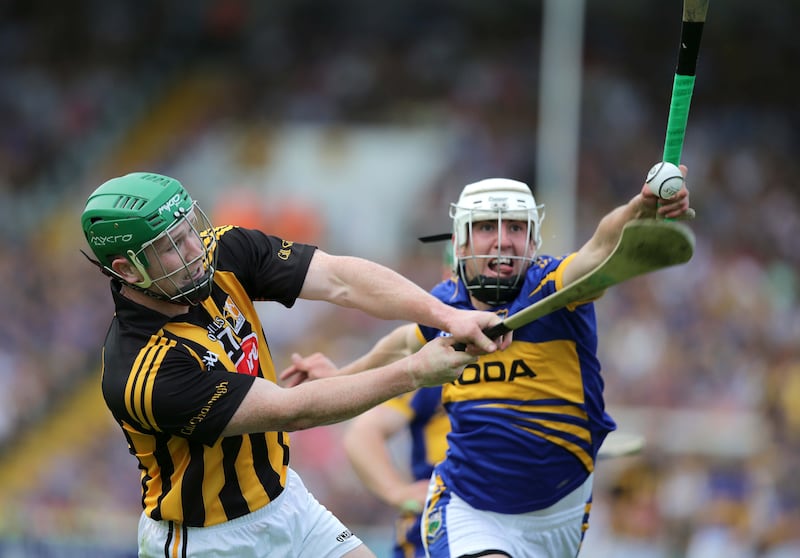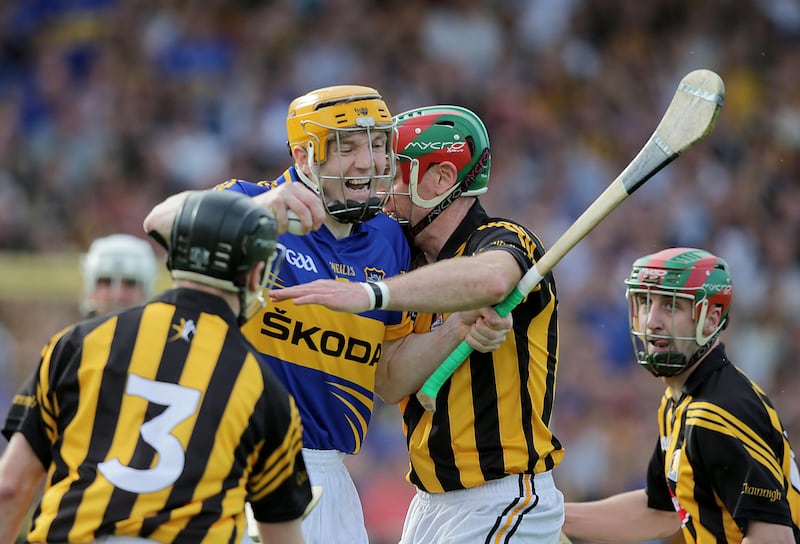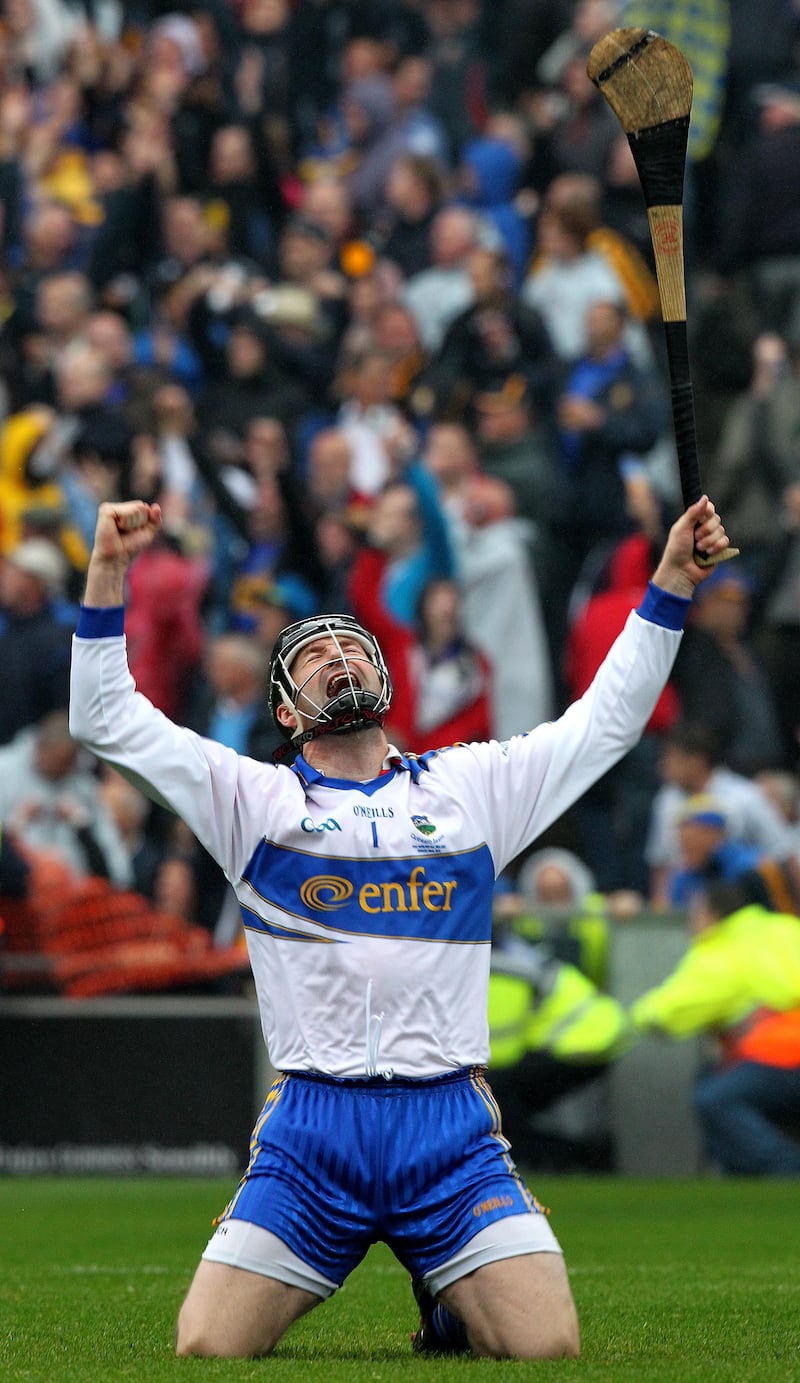In Nowlan Park, on a scorching summer evening in 2013, all of the hard feelings between Kilkenny and Tipperary were distilled to the pure drop. A slump in form had landed them both in the qualifiers and, as it turned out, the All-Ireland would be decided without them. On that evening, though, there were no other worlds to conquer.
Brian Hogan still remembers sitting in the Kilkenny dressingroom before the match, grilling slowly, like ribs on a barbecue. “You can always hear a bit of noise when someone opens the door but sitting in your seat in the dressingroom there was a kind of energy emanating from the stands. It was probably the most surreal experience of my life. Word came in that the place was full for two hours before the match.
“This was shit or bust. It was just unthinkable to lose a championship match in Nowlan Park to Tipperary.”
And that was the thing: it was only about each other. It was the deep-down essence of a Test match. In every rivalry, history keeps rolling and the mood changes colour, but nothing matters more than the latest score.
RM Block
“It was only the first round of the qualifiers, so the winner gets nothing,” says Richie Hogan. “But it was all about not losing. It was so heavily weighed on not losing rather than winning. The consequences of losing to Tipperary were gigantic.”
Brian Gavin had been pencilled in to referee the Leinster final a day later, but when the qualifier draw had paired two fighting cocks, he was rerouted to Nowlan Park. Gavin had refereed the 2011 All-Ireland final between them and would be the man in the middle for two other finals in 2014 and 2016; those games, though, were nothing like this.

“Refereeing Kilkenny-Tipperary championship in those years was like walking on a cliff edge,” Gavin said years later. “There was the exhilaration of being so close to danger and the joy of the view, but you knew it was a match that could end you as a referee.”
There was belting from the throw-in and after about 10 minutes Gavin could hear a rumble from the belly of the volcano. “Something started with Eoin Larkin,” Gavin says now, “so I went in and actually pushed him back. I shouldn’t have done it, but I was just letting them know that I didn’t want anything to start. Because of the atmosphere that night, something could have just ignited.”
Kilkenny won a low-scoring game that was strangled with tension. “If that Tipperary team were any good,” wrote Jackie Tyrrell in his autobiography, “they would have beaten us in 2013. We were on the floor at the time.”
Whatever Tyrrell said, losing was the ultimate insult.
That match came dead in the middle of the greatest decade in hurling’s bitterest rivalry. Between 2009 and 2019, Kilkenny and Tipperary met in nine championship matches, seven of which were All-Ireland finals, including a replay. For a salad on the side, there were four league finals too.
Like in a game of skins, the stakes kept rising. Nothing was ever resolved. Neither of them scooped the pot. A settlement on the steps of the court was out of question. Neither party was innocent.

The dynamics of the relationship were bound up with machismo and the over-arching past. Before 2009, Tipp and Kilkenny had only met four times in the championship in the previous half a century, but the long history between them was deposited in the soil, like minerals.
There was an 80-year period in which Kilkenny only beat Tipperary once in the championship and Kilkenny’s suffering was compounded by character assassination. “Kilkenny for the hurlers, Tipp for the men,” ran the taunt. Though the phrase had fallen out of general circulation it hadn’t been erased from Kilkenny’s race memory.
“I was only made aware of that in Jackie Tyrrell’s book,” says Paul Curran, the former Tipp captain, who spent 13 years on the panel. “He references it a lot. That was obviously spoken about more in Kilkenny than we were aware of. That’s probably where the dislike of Tipperary was bred into them.”
Until Tipp and Kilkenny started meeting in Croke Park again, a lot of that stuff had lain dormant. The hostility, though, was an inheritance. “You’re talking to some of the older generation,” says Brian Hogan, “and you’re hearing stories about the 50s and 60s and Kilkenny getting butchered by Tipperary and Tommy Walsh losing the eye [in the 1967 League final] – it all came back to the surface.”
“That just became a lightning rod for us in that period,” says Richie Hogan. “We weren’t just going to beat Tipperary on the pitch, we were going to beat them in the battle as well. We might lose a couple of matches along the way, but it was unforgivable to be beaten in terms of the fight. That was definitely the attitude in our dressingroom.”
In that decade, some of the matches were extraordinary. The All-Ireland finals of 2009 and 2010 and the drawn match in 2014 were among the greatest in living memory. “If you were taking your last breath,” said Brendan Cummins, “you would want to remember how you felt down on that field in those matches [the finals of ’09 and ’10]. You will never feel more alive than you were out there.”

In the 2009 final both teams scored more than 20 times for the first time in the history of All-Ireland finals; in the drawn 2014 final there were 20 different scorers from play and more scores than in any 70-minute final, ever. They drove each other to it.
“For the 2010 final we were so tuned in that I didn’t even know it was raining until the game was over,” says Curran. “I didn’t know Larry [Corbett] had scored three goals. The year before, I switched off, and I think we all switched off, for 30 seconds and it cost us. I promised that wasn’t going to happen again.”
In those years, the pendulum of imperatives kept swinging. One crowd or the other would draw a line in the sand, oblivious to the next tide. The laser focus that framed Tipp’s performance in 2010 was reciprocated by Kilkenny a year later. The clinical fear of losing was exchanged, over and back.
“Of all the times we met in the championship [in that period] that’s the only time we were underdogs,” says Richie Hogan. “Everything about that game was different [for us]. We did a huge amount of video analysis. We wanted to cover everything off. That was brought about by the fear of losing.”
Tipperary players from that era often refer to the 2009 league final in Thurles, which Kilkenny won after extra-time. For Tipp, though, it was a watershed. Only a few weeks earlier Kilkenny had beaten Tipp by 20 points in Nowlan Park, the kind of punishment beating that Cody’s teams often administered to prospective challengers, as a twisted compliment.
“I remember going in at half-time,” said Curran years later, “and their supporters were basically frothing at the mouth. It was a case of ‘lock the gates’.”

For the league final, though, Tipperary made a stand that would sustain their attitude for the next 10 years. “Jesus, the hits,” says Curran. “Séamie Callanan thundered into Brian Hogan and did his collar bone. Eddie Brennan caught me and if I had stayed down, he probably would have got sent off. But you didn’t stay down, you just got up. You didn’t want to show any bit of weakness.”
And yet Kilkenny never stopped probing for weaknesses, convinced they would find some. Every game was like an interrogation by the secret police. “We believed we could intimidate some of their forwards,” wrote Tyrrell in his autobiography. “They had flaky lads over the years.
“[In the 2012 All-Ireland semi-final] once we got a run on Tipp we mowed them down. It was the same old Tipp again – shaping and hiding behind their bullshit. They hadn’t the balls to come out and take us on man for man.”
Of all the games in that decade, the 2012 semi-final was the only crock. Tipp imploded and Kilkenny won by 18 points.
“We probably got our preparation wrong for that game,” says Eoin Kelly, the former Tipperary captain. “We went on a training camp to Bere Island on a Friday and Saturday two or three weeks out from the game and then played important club matches on the Sunday. A lot of injuries came from that. It’s not an excuse, but we had a lot of lads bandaged up that day. When the thing went wrong, it went absolutely wrong. The competitiveness to stay going just wasn’t there, physically or mentally.”
That was the day when Corbett insisted on marking Tommy Walsh and Tyrrell insisted on marking Corbett, while Pa Bourke struggled to make his insistence count for anything in the farcical merry-go-round.

It was also the day when Michael Rice was injured by a wild pull from Pádraic Maher under the Hogan Stand. Through all those years, and all the flaking, there were very few false strokes or massive flare-ups. Gavin remembers a league game where a player from each side wrestled on the ground “punching each other on the helmet”, but that kind of madness was scarce enough.
In the six All-Ireland finals they contested in that decade, two players were sent off: Benny Dunne in 2009 for a reckless swing under a dropping ball, and Richie Hogan 10 years later for the kind of challenge that caused Chris Crummey to miss this weekend’s semi-final.
“During my time, and I often said it, we wanted Tipperary to be the best form of Tipperary,” says Richie Hogan. “We wanted to test ourselves against the best. If it ever came up in a prematch meeting, ‘They’re going to bring it to us physically,’ straight away somebody would say, ‘We hope they do. Don’t just expect it, hope for it. Let’s hope that this is as hard as possible because that makes it worth it.’
“Brian Cody and Martin Fogarty and Michael Dempsey, they were trying to get us to think about the history of Tipperary and Kilkenny, probably thinking that it might arouse something different in us. But we were a team that wanted to make our own history. We didn’t care about what happened in the 50s and 60s and Hell’s Kitchen and all that. None of that stuff registered with us. It was just that it wasn’t going to happen to us.
“We always felt, ‘Do you know what? That’s their problem.’ We make our own history, and this is the way it’s going to go.”
The pain and the glory flowed back and forth. Kilkenny beat Tipp to win four All-Irelands in a row, and Tipp spiked their attempt at five. In the All-Ireland finals of 2016 and 2019, Tipperary inflicted two of the heaviest losses of Cody’s reign. He grew up with the 50s and 60s stuff. Those defeats would have cut him to the bone.
This weekend, two new teams will pick up the thread. All they need to know is what their gut tells them. Losing will be poison.






















